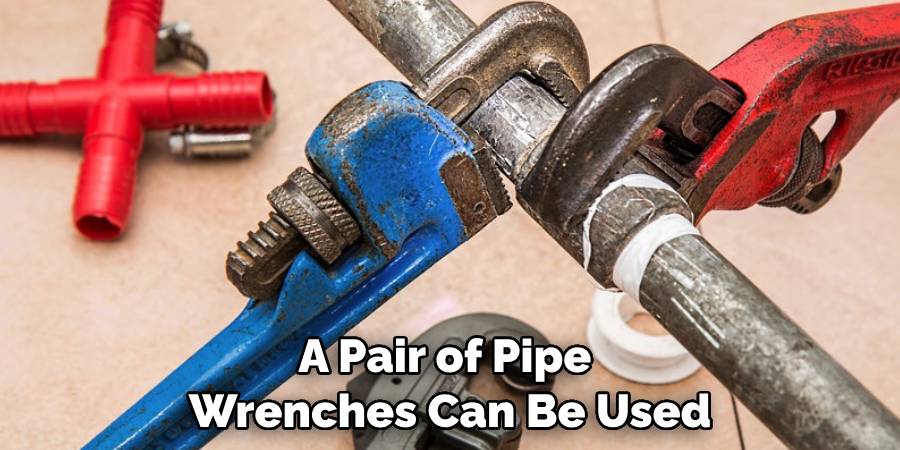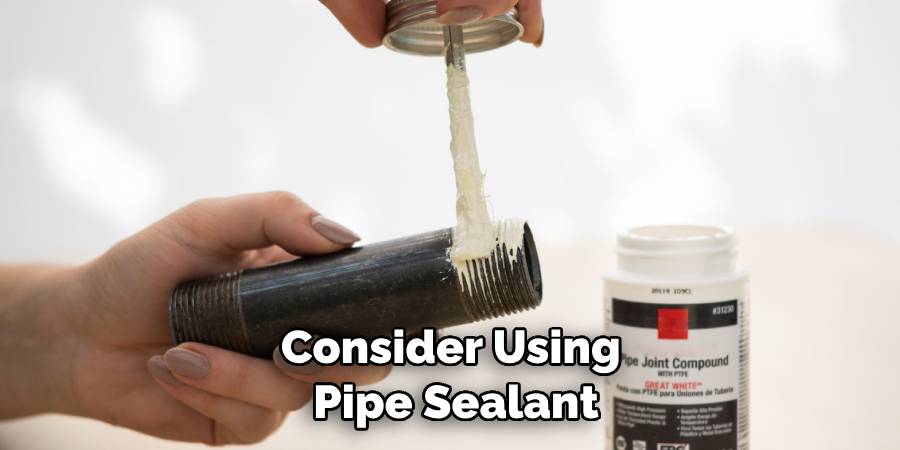Plumbing pipes are essential components of our homes, helping to bring water and remove wastewater on a daily basis. However, over time, these pipes may become tight due to various reasons such as mineral build-up or improper installation. Tight plumbing pipes can lead to reduced water flow, leaks, and even burst pipes. Therefore, it is important to know how to loosen plumbing pipes in case you encounter this issue.
In this guide, we will discuss the different methods and techniques that can be used to loosen plumbing pipes. These methods are easy to follow and can be done by anyone, whether you have prior plumbing experience or not. So let’s dive in and learn how to loosen those tight pipes!

Tools Are Needed
Before we get into the steps, let’s first gather the necessary tools and materials that will be needed for this task. You will need:
- Adjustable wrench
- Pipe wrench
- Slip-joint pliers
- WD-40 or any lubricant spray
- Clean rags or towels
It is important to have these tools on hand before starting the process so that you do not have to stop midway and search for them. Now, let’s move on to the different methods that can be used to loosen plumbing pipes.
Why Need to Loosen Plumbing Pipes?
There are various reasons why you may need to loosen plumbing pipes. Some of the common reasons include:
- Mineral Build-up: Over time, minerals from hard water can accumulate inside your pipes and cause them to become tight.
- Improper Installation: If the pipes were not installed properly in the first place, they may become too tight or even misaligned.
- Age and Wear: As pipes age, they can become corroded or damaged, causing them to tighten and restrict water flow.
Knowing the reason behind your tight plumbing pipes can help you determine the best method to use for loosening them. Let’s now look at some techniques that you can try.
10 Effective Ways on How to Loosen Plumbing Pipes
When plumbing issues strike, it’s not just the drip-drip sound that starts to grate on your nerves – it’s also the perplexing process of fixing them. Whether you’re a DIY enthusiast or just trying to hold things together until the professionals arrive, navigating the labyrinth of pipes can be as daunting as deciphering a medical chart. Here’s a listicle to the rescue, offering you 10 effective methods to loosen up those plumbing puzzles and restore the free flow of water in your home.
1. Turn Off the Water
Before you pop a single pipe, make sure to turn off your water supply at the main shutoff valve. This is an often overlooked step that can lead to disaster if neglected. Don’t just rely on the local shutoff valves; sometimes those are just as stubborn as your problem pipe. Ensuring no water pressure is pushing through your system will make the entire process smoother and less messy — both prerequisites for a successful plumbing adventure.

2. Apply Heat
If the pipe you’re working with is metal, applying heat can be a game-changer. A heat gun or even a hairdryer set on high can warm the metal and expand it, breaking up any tough connections due to rust or corrosion. Be extra cautious, though; keep the heat even as best as you can to prevent any warping or other damage to the pipe or surroundings.
3. Use Penetrating Oil
Penetrating oils like WD-40 or PB Blaster are excellent at seeping into the threads of tight connections and breaking up rust and corrosion. Spray the affected areas generously, and give the oil some time to work its magic before attempting to turn anything. The trick is to be patient — the longer you wait, the more likely the oil can do its job.
4. Employ a Pipe Wrench
A good pipe wrench is your best friend when dealing with stubborn pipes. Its adjustable, toothed jaws provide a strong grip on the pipe without slipping. When using a pipe wrench, always remember to turn the wrench in the direction of the tightening to avoid stripping the pipe threads.
5. Try a Plumber’s Socket Set
For larger, more industrial pipes, sometimes a standard wrench or pipe wrench may not do the trick. A plumber’s socket set lets you use a ratchet system to turn the pipe, applying more torque with less effort. This can be particularly useful in cramped spaces where a full rotation of a wrench may not be possible.
6. Apply Tapping and Vibrations
For especially stubborn connections, give the pipe and the area around the connection a few taps with a hammer. The vibrations help break apart the rust that’s holding the connection in place. This method, combined with some of the earlier ones, can be a triumphant trio in loosening your plumbing woes.
7. Secure the Other End
If you’re dealing with a situation where you’re trying to turn a pipe that just keeps spinning, try securing the other end with vice grips or a second pipe wrench. By anchoring one end, you can apply more force to the other, increasing your leverage and the likelihood of the connection separating.
8. Use Two Wrenches for Tough Unions

Sometimes, you’ll encounter a union that’s so tight, even a pipe wrench struggles. In these cases, a pair of pipe wrenches can be used to counteract each other’s force. Place one wrench on the pipe itself and the other on the fitting. Then, move them in opposite directions. It requires some coordination, but it’s a powerful way to budge even the most obstinate setups.
9. Apply a C-Clamp
If you’ve got metal pipes, a C-clamp lends an approachable way to tackle a difficult joint. Position it securely over the joint area and slowly tighten. The consistent pressure can sometimes be enough to persuade the joint to loosen without damage.
10. Don’t Force It
Sometimes, after all the tricks in your toolbox have been tried, a professional touch is what’s really needed. Forcing a pipe can lead to a breakage or, in the best-case scenario, a stripped thread. Knowing when to call for backup is just as important as knowing how to handle a wrench — it ensures that the plumbing problem gets fixed properly, the first time.
Navigating the twists and turns of your home’s plumbing system can feel like an unsolvable maze at times. However, with these 10 effective approaches to loosen plumbing pipes, you’re well-equipped to handle most dilemmas that may spring a leak in your daily life. Always work methodically, be patient, and remember that the key to success with plumbing is often a light touch and a clever maneuver, not brute force.
Frequently Asked Questions
Which Way Do You Loosen Plumbing?
Plumbing perplexities can ensnare even the most intrepid DIY enthusiasts, but fear not, for the golden rule of “lefty-loosey, righty-tighty” reigns supreme in the realm of wrenches and washers. When grappling with obstinate pipes, a firm grasp and a turn to the left can often yield the give you seek.

Remember to wrap your tools with cloth to protect the finish and summon patience—sometimes, it’s the slow, deliberate dance of pressure and release that coaxes the threads to surrender. Whether you’re cautiously combatting corrosion or artfully avoiding a watery catastrophe, this timeless twist technique is the quintessential keystone of knowing how to loosen plumbing pipes—a valuable nugget of know-how that can save both your sanity and your seals.
When Should You Call a Professional Plumber?
If you’ve tried all 10 methods and still can’t budge that stubborn pipe, or if you’re dealing with complex plumbing issues like blocked drains or mainline clogs, it may be time to call in the professionals. While DIY solutions are great for minor plumbing problems, hiring an experienced plumber guarantees a proper fix and can save you time, money, and frustration in the long run. Plus, they have specialized tools like hydro-jetters that can clear even the toughest blockages with ease.
Remember to always prioritize your safety and well-being when dealing with plumbing issues. If you feel unsure or uncomfortable handling a problem on your own, don’t hesitate to reach out to a professional for assistance. That way, you can rest easy knowing the job will be done right and your plumbing system will be in good hands. Overall, knowing when to call for help is just as important as having the know-how to handle basic plumbing tasks on your own.
How Can You Prevent Pipes from Becoming Loose or Tight?
Prevention is key when it comes to keeping your pipes in tip-top shape. Here are a few simple tips to help prevent loose or tight connections:
- Regularly inspect and maintain your plumbing system, looking for any signs of wear and tear, leaks, or corrosion.
- Use high-quality materials when installing new pipes or fittings.
- Avoid using excessive force when tightening connections.
- Consider using pipe sealant or tape to ensure a secure seal.
- If you notice any issues with your plumbing, address them promptly before they become bigger problems.
By taking these preventative measures, you can help keep your pipes in good condition and avoid the need for frequent repairs or replacements. Remember, proper maintenance is always more cost-effective than dealing with major plumbing disasters.

Conclusion
In this guide, we’ve covered 10 effective methods for how to loosen plumbing pipes, ranging from simple tricks like using heat or lubricant to more advanced techniques involving multiple wrenches. By following these tips and being patient and methodical in your approach, you can handle most common plumbing problems on your own with confidence.
However, it’s also important to know when to call a professional for help, and to prioritize preventative maintenance to keep your plumbing system in good working condition. By keeping these tips in mind, you can navigate the twists and turns of your home’s plumbing system with ease and confidence, ready to tackle any challenge that comes your way. Happy fixing!
